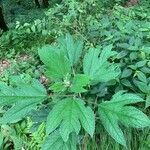Herbs, annual or perennial, dioecious or monoecious. Stems often woody at base, straight, branched or not, 5-angled, 25-200 cm tall; stems and petioles spreading pubescent and armed with stinging and stigose hairs. Stipules oblong-ovate, 1-3 cm, sparsely strigose abaxially; petiole 2-15 cm; leaf blade light green, elliptic, ovate or oblate in outline, sometimes 3-lobed, 5-25 × 4-23 cm, herbaceous, 3-veined, lateral veins 3-5 each side, anastomosing before margin, abaxially sparsely pubescent and with armed stinging and setulose hairs, adaxially sparsely appressed strigose and armed with short stinging hairs, base cordate or subtruncate, margin usually 3, 5, or 7-lobed or, rarely, regularly serrate or sometimes doubly serrate at leaf base, apex short acuminate or acute; cystoliths minutely punctiform. Glomerules densely armed with stinging hairs. Male inflorescences in proximal axils, spicate, cymose-racemose or subpaniculate, 5-11 cm; female ones in distal axils of stem or in same axils as male, sometimes solitary, racemelike or paniculate, rarely long spicate, 1-28 cm, strigose and spreading hirsute. Male flowers subsessile or pedicellate, in bud 1 mm; perianth lobes 4, ovate, concave, setulose abaxially, apex acute, stamens 4; rudimentary ovary cupular. Female flowers ca. 0.5 mm; perianth lobes unequal, the larger connate lobe cymbiform, 0.4 mm, enlarged to 1 mm at fruit, sparsely strigillose on outside, apex 3-toothed, the smaller lobe linear. Achene dark brownish to gray-brown, subcordate to broadly ovoid, slightly compressed, 1.5-3 mm in diam., conspicuously verrucose. Fl. Sep-Oct, fr. Oct-Nov.
Erect, probably annual herb up to 1 m high. Stems with stinging and stiff hairs. Leaves broadly ovate in outline, deeply 3-5-lobed, or unlobed near base of plant or on side shoots, 111-170 x 90-170 mm, apical tooth longer than broad, base cuneate to truncate, margin with 19-24 pairs of broad teeth, each tooth sometimes with a single adaxial lobe, densely covered with long stinging hairs 3-7(-9) mm long, these scattered on upper surface, concentrated along veins on lower surface, stiff hairs also present; petiole 55-90 mm long, with stinging and adpressed stiff hairs; stipules lanceolate, ± 8 x 3 mm, fused, except for the free, attenuate apices. Female inflorescence densely cylindrical, 1 or 2 per node, 35-75 mm long; peduncles densely covered with long, hard, pungent stinging hairs up to 4 mm long. Male inflorescence not seen in material from FSA region, thin and spike-like, 1 or 2 per node, 50-80 mm long; peduncle covered with stiff hairs. Female flowers sessile, without free fourth tepal, ±2 mm long, with thick unilateral dorsal ridge. Male flowers on pedicels ±1 mm long; tepals without subapical horn-like appendage. Achenes ovoid, laterally compressed, strongly rugose over whole surface, 3-4 mm in diameter, dark brown when mature.
Leaves usually fallen from the lower part of the stem at anthesis, 10–20(25) x 10–18(23) cm., ovate to cordate but extremely variously lobed or divided (lamina of the younger leaves usually the least divided); apices of entire leaves and of lobes acuminate; base cuneate, truncate or cordate; margin dentate (with 20–25 teeth on each side in undivided leaves), teeth fine to coarse; lamina not bullate, triplinerved, upper surface glabrescent except for the stinging hairs, lower surface pubescent and with stinging hairs on the nerves.
A stout herb. It is an annual plant. It grows to 3 m high. The leaves are 10-24 cm long by 7-18 cm wide. It is divided deeply like fingers on a hand. There are teeth around the edge. They are covered with long stinging hairs. The base has 3 ribs. The flowers are yellow. They are clustered in a loose flower cluster.
Female inflorescences thicker than the males, densely cymose, consisting of small dichasia 2–3 cm. long at anthesis but elongating to 10–15 cm. during ripening of fruit; flowers sessile, perianth c. 2 mm. long with 3 fused tepals, a free fourth tepal usually absent, ovary enclosed in perianth, stigma filiform.
Male inflorescences narrow, spicate panicles on peduncles to c. 2 cm. long; flowers on pedicels c. 1 mm. long, clustered, perianth 4–5-merous, tepals without dorsal appendages, rudimentary ovary present
Erect herb, up to 1 m high. Stem, leaves and peduncles densely covered with long stinging hairs, up to 4 mm long. Hairs of inflorescences hard and pungent.
Stem sparsely branched, pubescent and covered with stinging hairs 7–9 mm. long, and with short stiff hairs.
Stipules linear-lanceolate, fused for at least four fifths of their length, usually fallen at anthesis.
Erect annual or short-lived perennial herbs to 1.5(2) m. tall, monoecious or dioecious by abortion.
Achene up to 2 mm. long, ovoid to subcordate, compressed, rugose.
Petioles 3–15 cm. long, densely beset with stinging hairs.
Inflorescences unisexual, cylindrical, up to 10 cm. long.
Cystoliths dot-like.

